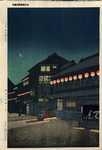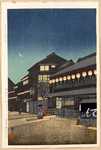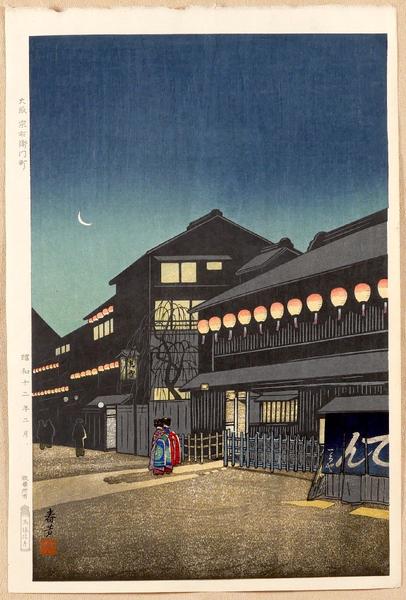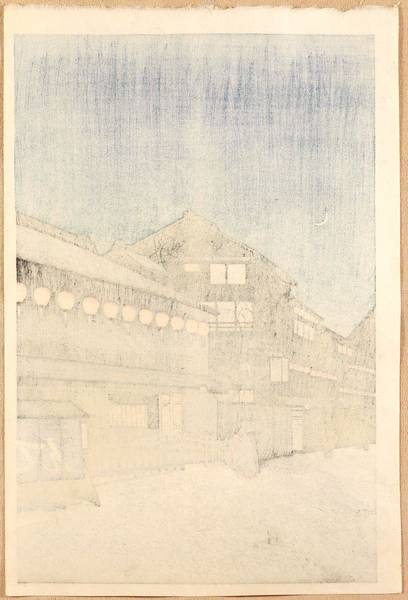| | |
| Artist: | Shunho - Haruyoshi — 春芳 |
| Title: | Souemon-cho, Osaka — 大阪宗右衛門町 |
| Series: | |
| Date of first edition?: | 1937/2 |
| Publisher (first edition)?: | Baba Nobuhiko — 馬場信彦 |
| Publisher (this edition)?: | Baba Nobuhiko — 馬場信彦 |
| Medium (first edition): | Woodblock |
| Medium (this edition): | Woodblock |
| Format (first edition): | Oban
|
| Format (this edition): | Oban |
| DB artwork code: | 48036 |
| Notes (first edition)?: |
Similar to the Kawase Hasui scene.
Title: Soemoncho in Osaka
Signature: Shunho.
Seal: In red.
Dated: 1937, February.
Publisher: Baba Nobuhiko.
Technique: Woodblock print
絵師 春芳(Shunho? Haruyoshi?)
題名 大阪 宗右衛門町
時代 昭和12年(1937年)
サイズ 大判 (縦42.3cm×横29cm) |
|
| Notes (this edition)?: |
| The following information was taken from the original web listing of this artwork. Note that there may be some inaccuracies:
Title: Soemoncho in Osaka
Signature: Shunho.
Seal: In red.
Dated: 1937, February.
Publisher: Baba Nobuhiko.
Technique: Woodblock print
Very Rare.
Width Item: 11.2 inches = 28.5 cm
Height Item: 16.7 inches = 42.5 cm
Width Image: 10.2 inches = 26.0 cm
Height Image: 15.6 inches = 39.5 cm
Description
"Osaka, Soemon-cho". The crescent moon shines quietly in the dark sky over the plush Soemoncho district in Osaka. Two maikos (Japanese traditional dancers) and three other people are strolling on a street. Hanging lanterns are lining up in front of the silhouetted restaurants. Lights are coming out from the windows and entrances of the restaurants, casting long shadows on the street.
Hasui made a similar design depicting Soemoncho district in 1933.
"Hanken shoyu, Baba Nobuhiko" (Copyright by Baba Nobuhiko) K100-BN seal is stamped on the left margin. |
|
| Artist Bio: |
Shunho was probably a publisher's pseudonym used for knock-offs of scenes by well-known artists. It has been suggested that Shunho was a pseudonym for Tsuchiya Koitsu (remember that Koitsu published quite a few prints via the publisher Baba in the 1930s). Take for example Shunho's Zojoji scene. Yes, it does look similar to Koitsu's Zojoji scene, especially the colour scheme, and it is of course possible that, after the war, when Baba re-established his business, Koitsu sold Baba some previously unpublished sketches that Baba published after Koitsu's death.
However, there is ample evidence to prove, beyond a reasonable doubt, that Shunho was not Tsuchiya Koitsu or any other known artist. For example, please note that the Zojoji print is dated 昭和二十九年作 (Showa 29, or 1954), and that Tsuchiya Koitsu died in 1949. The margin text is very similar to Tsuchiya Koitsu's hand writing, but obviously he could not have written the margin text, including the date of 1954. I'm thinking here that Baba simply took advantage of Koitsu's passing and reproduced this similar scene using his own carvers and printers, including the same colour palette and hand writing style.
The strongest evidence that Shunho was an in-house artist of "knock-off" reproductions for the publisher Baba can be found by searching for the artist Shunho in my JAODB database. There we can clearly see that Shunho prints are simply reproductions (fakes) of several scenes by Tsuchiya Koitsu (Zojoji, Miyajima in Snow, etc.) and Kawase Hasui (Night Scene at Soemoncho).
|
|







